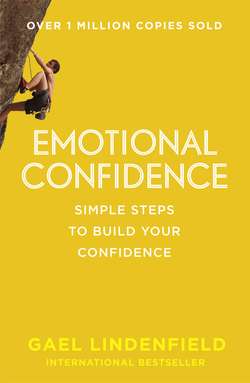Читать книгу Emotional Confidence: Simple Steps to Build Your Confidence - Gael Lindenfield, Gael Lindenfield - Страница 8
ОглавлениеHow to Use this Book
I have designed this self-help programme so that you can work on it over a set period of time, either on your own or in a small group. Reading it and completing the exercises will, first, give you more understanding of how your emotions work, and secondly improve your ability to manage specific feelings. I am hoping that after using it in this way you will continue to keep it in a handy position, because I have tried to design it in such a way that it can be a useful practical tool. Should you ever experience a problem with a feeling in the future (and who won’t?!), you will be able to dip into the relevant section, take some support and remind yourself of a strategy which will help you to regain your control.
A Quick Tour through the Book
WHY WE NEED EMOTIONAL CONFIDENCE
This section is designed to boost your motivation, so I have listed 25 reasons for building and maintaining emotional confidence. I hope that these will inspire you not just to skim lightly through the rest of the book but to work mentally as you read!
PART 1: THREE KEYS TO BUILDING EMOTIONAL CONFIDENCE
Key 1: Tame Your Temperament– with Emotional Understanding and Skill
In Understanding How Feelings Work I have given a brief explanation of how our emotional responses function, and a simple summary of research findings we have to date. There are exercises and check-lists which will help you apply this theory to your own everyday experience of your feelings.
In Skills for Taking Control you will find a questionnaire designed to help you assess the level of your current emotional skills. Should you find that these need improving, I have also given you some suggestions and examples of a few of my own favourite techniques.
Key 2: Soothe Your Sensitivity – with Effective Emotional Healing
In this section you will find a fully illustrated explanation of my Emotional Healing Strategy for dealing effectively with feelings such as sadness, hurt and disappointment. I explain this strategy in depth, with appropriate exercises.
Key 3: Harness Your Habits– with Positive Strategies for Runaway Feelings
In this section you will find tips, strategies and exercises to help you take control of your self-sabotaging emotional habits. It first introduces a general Quick-Fix strategy called ACHE; then the focus shifts to eight specific emotions which many people find difficult to control at times. These are:
| Guilt | Fear |
| Shame | Jealousy |
| Envy | Apathy |
| Anger | Unbridled Love |
Even if these are not the emotions you tend to find difficult, you should be able to use the approaches and exercises offered to work on the ones with which you do have difficulty.
PART 2
This includes some suggestions for maintaining emotional confidence and helping to foster it in others. It also includes the Further Reading and Resources chapter, the Index and some blank pages for your own notes.
To Read On or Not to Read On – Is that Your Question?
You have probably gathered by now that this book is not necessarily going to be a quick or easy read. You may even have glanced through its pages and begun to feel a little daunted. This is an understandable reaction and one which is very familiar to me. In fact, whenever I am faced with changing any aspect of my feelings or behaviour, I feel this way. I then find myself automatically thinking of a million and one reasons why I don’t need or want to take up the challenge, now or ever. I start to put up a convincing case for not having the time or the energy to devote to the work, or I don my cynic’s hat and focus on the other problems this work won’t solve, or I persuade myself that I haven’t the difficulty after all!
In my case, this self-sabotaging thinking process is merely a pre-programmed response to uncomfortable feelings (usually of fear and anxiety). I have learned to take some ‘time out’ – to calm down and take control of my feelings before making my decision. This usually involves doing a familiar activity which both relaxes and reassures me (e.g. a warm aromatic bath or a good clear-up in the kitchen accompanied by my favourite music). I find I am then more willing and able to look at the challenge in a more rational way.
So, before making your decision to read on, why not give yourself a nurturing and encouraging treat? Once you have done that, set aside some time to dip in and out of this book for a while. Read the Contents page and mark the bits which are a priority for you. Then (this is the crucial and often forgotten step!) you will need to take your diary and set aside some chunks of time over the next few weeks to work through your chosen sections step by step at a pace that suits you and your lifestyle. Hopefully, the task of building emotional confidence will then seem much more manageable, and instead of feeling daunted or anxious you will have fuelled yourself with an inspiring emotion – excitement!
Enjoy the journey, and be generous with the breaks and treats!
